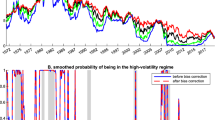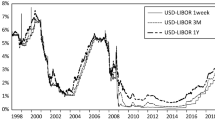Abstract
In this paper we extend the exact discrete model of Bergstrom (1966) first used in empirical finance by Brennan and Schwartz (1979) to estimate their two-factor term structure model to estimate other two-factor term structure models using the recent assumption in Nowman (1997) for single factor models. Following Nowman (1997) we use the exact Gaussian estimation methods of Bergstrom (1983–1986, 1990) to estimate two-factor CKLS, Vasicek and CIR models. We estimate the models using monthly UK and Japanese interest rate data and our results indicate that the estimation method works well in practice.
Similar content being viewed by others
References
Agbeyegbe, T. D. (1984) The exact discrete analog to a closed linear mixed-order system, J. Econom. Dynam. Control 7, 363-375.
Agbeyegbe, T. D. (1987) The exact discrete analog to a closed linear first-order system with mixed sample, Econometric Theory 3, 142-149.
Agbeyegbe, T. D. (1988) An exact discrete analog of an open order linear non-stationary first-order continuous time system with mixed sample, J. Econometrics 39, 237-250.
Andersen, T. G. and Lund, J. (1997) Estimating continuous time stochastic volatility models of the short term interest rate, J. Econometrics 77, 343-377.
Babbs, S. H. and Nowman, K. B. (1999) Kalman filtering of generalized Vasicek term structure models, J. Financ. Quantitat. Anal. 43, 115-130.
Beaglehole, D. R. and Tenney, M. S. (1991) General solutions of some interest rate-contingent claim pricing equations, J. Fixed Income 1, 69-83.
Bergstrom, A. R. (1966) Non-recursive models as discrete approximations to systems of stochastic differential equations, Econometrica 34, 173-182.
Bergstrom, A. R. (1983) Gaussian estimation of structural parameters in higher-order continuous time dynamic models, Econometrica 51, 117-152.
Bergstrom, A. R. (1984) Continuous time stochastic models and issues of aggregation over time. In Z. Griliches and M. D. Intriligator (eds), Handbook of Econometrics, Volume II, Elsevier Science, Amsterdam.
Bergstrom, A. R. (1985) The estimation of parameters in nonstationary higher-order continuous time dynamic models, Econometric Theory 1, 369-385.
Bergstrom, A. R. (1986) The estimation of open higher-order continuous time dynamic models with mixed stock and flow data, Econometric Theory 2, 350-373.
Bergstrom, A. R. (1989) Optimal forecasting of discrete stock and flow data generated by a higher-order continuous time system, Computers Mathematics Applications 17, 1203-1214.
Bergstrom, A. R. (1990) Continuous Time Econometric Modelling, Oxford University Press, Oxford.
Bergstrom, A. R. (1997) Gaussian estimation of mixed order continuous time dynamic models with unobservable stochastic trends from mixed stock and flow data, Econometric Theory 13, 467-505.
Bergstrom, A. R. and Nowman, K. B. (1999) Gaussian estimation of a two-factor continuous time model of the short-term interest rate, Economic Notes 28, 25-41.
Byers, S. L. and Nowman, K. B. (1998) Forecasting U.K. and U.S. interest rates using continuous time term structure models, Int. Rev. Financ. Anal. 7, 191-206.
Byers, S. L. and Nowman, K. B. (2000) Further evidence on the forecasting performance of two factor continuous time interest rate models in international and Asia-Pacific financial markets, Managerial Finance, forthcoming.
Brennan, M. J. and Schwartz, E. S. (1979) A continuous time approach to the pricing of bonds, J. Banking Finance 3, 133-155.
Chambers, M. J. (1991) Discrete models for estimating general linear continuous time systems, Econometric Theory 7, 531-542.
Chambers, M. J. (1999) Discrete time representation of stationary and non-stationary continuous time systems, J. Econom. Dynam. Control 23, 619-639.
Chan, K. C., Karolyi, G. A., Longstaff, F. A., and Sanders, A. B. (1992) An empirical comparison of alternative models of the short-term interest rate, J. Finance 47, 1209-1227.
Chen, R. and Scott, L. (1995) Multi-factor Cox-Ingersoll-Ross models of the term structure: Estimates and tests from a Kalman filter model, paper, Rutgers University.
Cox, J. C., Ingersoll, J. E., and Ross, S. A. (1985) A theory of the term structure of interest rates, Econometrica 53, 385-407.
Dahlquist, M. (1996) On alternative interest rate processes, J. Banking Finance 20, 1093-1119.
Duffie, D. and Kan, R. (1996) A yield-factor model of interest rates, Mathematical Finance 6, 379-406.
James, J. and Webber, N. (2000) Interest Rate Modelling, John Wiley & Sons.
Longstaff, F. and Schwartz, E. (1992) Interest rate volatility and the term structure: A two factor general equilibrium model, J. Finance 47, 1259-1282.
Malinvaud, E. (1966) Statistical Methods of Econometrics, North-Holland, Amsterdam.
Nowman, K. B. (1991) Open higher-order continuous time dynamic model with mixed stock and flow data and derivatives of exogenous variables, Econometric Theory 7, 404-408.
Nowman, K. B. (1997) Gaussian estimation of single-factor continuous time models of the term structure of interest rates, J. Finance 52, 1695-1706.
Nowman, K. B. (1998) Continuous time short term interest rate models, Appl. Financ. Econom. 8, 401-407.
Nowman, K. B. and Sorwar, G. (1999) An evaluation of contingent claims using the CKLS interest rate model: An analysis of Australia, Japan, and United Kingdom, Asia-Pacific Financ. Markets 6, 205-219.
Phillips, P. C. B. (1972) The structural estimation of a stochastic differential equation system, Economtrica 40, 1021-1041.
Saltoglu, B. (1996) Forecasting with a continuous time interest rate model: A comparision between continuous time and discrete time estimation methods, unpublished paper.
Saltoglu, B. (2000) Comparing forecasting ability of parametric and nonparametric methods: An application with Canadian monthly interest rates, unpublished paper.
Vasicek, O. (1977) An equilibrium characterization of the term structure, J. Financ. Econom. 5, 177-188.
Author information
Authors and Affiliations
Rights and permissions
About this article
Cite this article
Nowman, K.B. Gaussian Estimation and Forecasting of Multi-Factor Term Structure Models with an Application to Japan and the United Kingdom. Asia-Pacific Financial Markets 8, 23–34 (2001). https://doi.org/10.1023/A:1011436907037
Issue Date:
DOI: https://doi.org/10.1023/A:1011436907037




